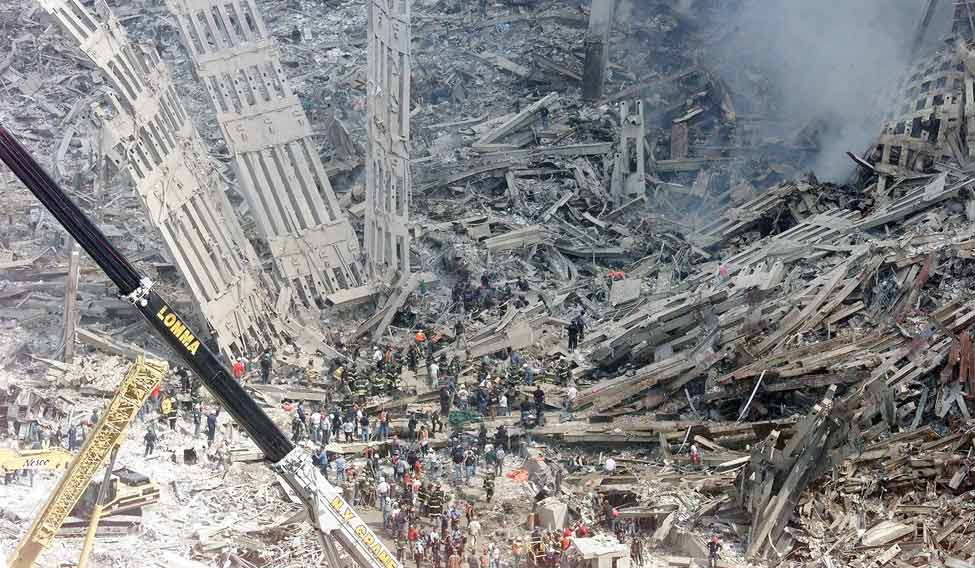Fifteen years after the collapse of the World Trade Center in New York City, researchers are still learning how the terrorist attacks of September 11, 2001, affected people’s health.
When the twin towers fell on 9/11, a cloud of hazardous materials enveloped the surrounding neighborhood, and coated everything and everyone exposed to it for several days. According to a new study, those dust clouds likely contributed to negative birth outcomes for Lower Manhattan mothers.
The study adds to a body of research showing that exposure to air pollution in the womb can have adverse health effects on newborns, and those effects can play out over the course of a lifetime.
For the study, published in the Journal of Human Resources, researchers Hannes Schwandt and Janet Currie looked at New York City birth records from 1994 to 2004. Of those 1.2 million births, they isolated data from women who lived in Lower Manhattan neighborhoods and so were the most exposed to the dust cloud. The team then refined their search for women who had previously had babies, to better determine if the low birth weights were an anomaly.
They found that women who were in their first trimester during 9/11 had more than double the probability of premature delivery. There was also an increase in the number of babies with low birth weights, which can lead them to issues such as higher risk for diabetes, heart disease and elevated blood pressure.
“The pregnancy conditions really matter for later economic outcomes and for long-term human development and economic success,” says Schwandt, an economist at the University of Zurich, whose research focuses on child development. In addition to the health risks, low birth-weight babies tend to earn less money throughout their life spans.
Wealthy, but not healthy
Another potential factor for the 9/11 mothers could be post-traumatic stress disorder (PTSD), which, like air pollution, has been linked to low birth weights. But after comparing stress levels across the city, the researchers were able to rule out PTSD as a confounding factor for the births in their study. Instead, they argue that the dust cloud was the primary culprit.
The study’s findings are striking because many of the affected women lived in well-to-do neighborhoods that are typically predisposed to better birth outcomes. In the United States, pollution and low birth weights tend to occur in poorer communities.
“In this case, we have these relatively wealthy mothers who then are affected, and we see that the magnitude of the effect is similar to the difference between an advantaged and a disadvantaged mother,” says Schwandt.
“So we could think of it like the advantaged mother that was exposed to the dust cloud in southern Manhattan had a similar birth outcome as a disadvantaged mother who has not been exposed,” he adds.
Previous studies looking at 9/11 babies had shown little evidence of such effects. But those studies either pulled data from specific hospitals or from all over the city—including poorer and more polluted areas such as the South Bronx, says Schwandt. Since the rates of prematurity are so high in some parts of New York City, that changed the data sets. Taken together, the numbers are comparable to what you would see in less advantaged nations.
Global problem of pollution
The study has implications for cities around the world that grapple with polluted air, such as New Delhi, Mexico City and Beijing.
Most other studies that have looked at air pollution’s effects on birth outcomes usually examined experiences occurring over lengthy periods of time. Because the terrorist attacks happened in a contained time and space, the researchers could better understand the effects of the resulting pollution. Essentially, this was the closest to a controlled environment as they could expect to get—the 9/11 dust cloud both simplified the variables and magnified the change.
A comparable study was done in Beijing when the city tried to clean its famously polluted air before and during the 2008 Olympics.
“In Beijing, the air pollution levels went down during the Olympics and then came back up, because they relaxed all the controls they had in place,” says the study’s co-author, Tracey Woodruff, a researcher at the University of California, San Francisco.
The Beijing study found that babies who were gestating during the period of cleaner air were about 23 grams heavier than babies born during the same time period the year before, when the air was more polluted.
For now, Schwandt and Currie do not have plans to follow through and see how the health and economic fates of the 9/11 babies have played out now that they are teenagers. But, they say their work stands on its own as a tool to exemplify the problems of air pollution exposure.
“That’s the whole reason why this kind of disaster research is useful in a sense, not because this is something that is very representative in general, but because it allows you to identify the effects of pollution,” says Schwandt. “It’s like switch on, switch off.”
RESEARCH
Hazardous 9/11 dust made newborn babies smaller
 File photo of a crane clearing debris at the World Trade Center disaster area after 9/11 terror strike in 2001
File photo of a crane clearing debris at the World Trade Center disaster area after 9/11 terror strike in 2001
This browser settings will not support to add bookmarks programmatically. Please press Ctrl+D or change settings to bookmark this page.



